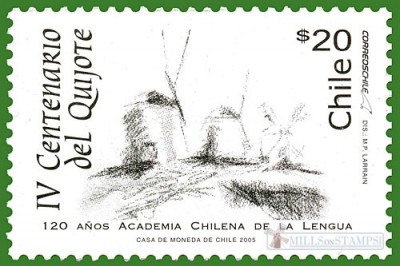-
400th Anniversary of publication of Don Quijotte. 120th Anniversary of Chilian Academy of Language
Chile 2005.07.14
In issue: Stamp(s): 4
Printing: offset, by strips of 4 stamps, as one set
-
Number by catalogue: Yvert: 1687 Scott: 1446b
Perforation type: 13 ¼x13 ½
Subject:
10 peso. An illustration of the book - a windmill from La Mancha
Additional:
Topics: Don Quijote Mills in Art Windmills
-
Number by catalogue: Yvert: 1688 Scott: 1446c
Perforation type: 13 ¼x13 ½
Subject:
20 peso. An illustration of the book - a windmills from La Mancha*
Additional:
*La Mancha is an arid, fertile, elevated plateau (610 m or 2000 ft.) of central Spain, south of Madrid, stretching between the Montes (mountains) de Toledo and the western spurs of the Cerros (hills) de Cuenca, and bounded on the south by the Sierra Morena and on the north by the La Alcarria region. It includes portions of the modern provinces of Cuenca, Toledo, and Albacete, and most of the Ciudad Real province. It constitutes the southern portion of the Castile-La Mancha autonomous community and makes up most of the region.
"Manxa" means parched earth in Arabic; hence La Mancha is not definitively related to the Spanish word "mancha", or stain, which is derived from Latin "macula".
Miguel de Cervantes gave international fame to this land and its windmills when he wrote his novel Don Quixote de La Mancha, later the inspiration for Dale Wasserman's musical Man of La Mancha. Some believe[citation needed] that Cervantes was making fun of this region, using a pun; a "mancha" was also a stain, as on one's honor, and thus a hilariously inappropriate homeland for a dignified knight-errant. Translator John Ormsby believed that Cervantes chose it because it was/is the most ordinary, prosaic, anti-romantic, and therefore unlikely place from which a chivalrous, romantic hero could originate, making Quixote seem even more absurd.
A great number of experts think of La Mancha as the most proper place for an idealist, since it was, as it is still today, a very harsh and ruthless area.
Several film versions of Don Quixote have actually been filmed largely in La Mancha. However, at least two of the most famous - the 1957 Russian film version, and the screen version of Man of La Mancha, were not. The 1957 film was shot in Crimea, while Man of La Mancha was filmed in Italy. G.W. Pabst's 1933 version of Cervantes's novel was shot in Alpes-de-Haute-Provence.**The Academia Chilena de la Lengua (Spanish for Chilean Academy of Language) is an association of academics and experts on the use of the Spanish language in Chile. It is a member of the Asociación de Academias de la Lengua Española.
It was founded in Santiago de Chile (capital of country) on June 5, 1885. It started out with 18 members designated by the Real Academia Española (Royal Spanish Academy). Today, it has 36 academics, plus members in several Chilean regions and abroad.Topics: Don Quijote Mills in Art Windmills



2005-strip-logo.jpg)

